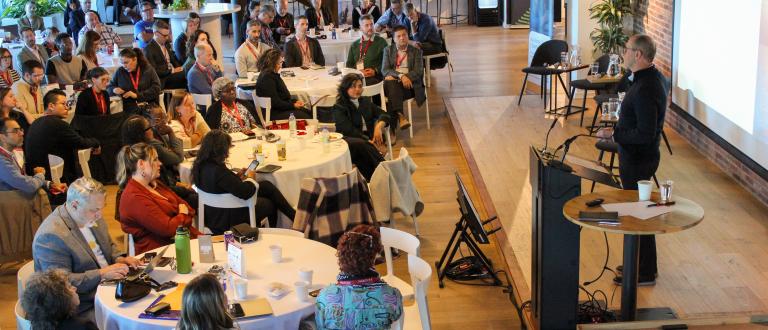Photo by CIRA/.CA.
Charities and nonprofits contribute to addressing some of the most pressing social and economic inequities. But having a social mission doesn’t mean an organization is intentionally and meaningfully incorporating equity, diversity and inclusion (EDI) principles into its work. From the summary blog post about the study Shifting Power Dynamics: Equity Diversity & Inclusion in the Nonprofit Sector, Equitable Recovery Collective 2023
As executive recruitment professionals, we’ve had the opportunity to work with a wide range of nonprofit organizations across the country. Most of our clients have identified equity and belonging as key strategic priorities and central to their organizational values. In addition to helping them recruit new team members, we often find ourselves helping our clients embed equitable and inclusive practices into their recruitment process. This means that we are sometimes coaching and sometimes learning from our clients…and often both at the same time!
Incorporating equity into hiring processes is not only the right thing to do, but it is also the smart thing to do in a competitive labour market where organizations are struggling to recruit and retain great talent. Imagine if your recruitment practices increased your pool of qualified candidates and helped you make smarter hiring decisions? In fact, these are natural outcomes when organizations make a conscious effort to embed equitable and inclusive practices into their hiring.
Barriers to Equitable Hiring Processes
The Equitable Recovery Collective Shifting Power Dynamics: Equity Diversity & Inclusion in the Nonprofit Sector study found that focus, intentionality, and buy-in are the biggest enablers for organizations seeking to advance EDI. Therefore, shifting mindsets and dedicating time and resources to equitable hiring processes are critical to making meaningful progress.
So why doesn’t progress happen? We have been asked many times what prevents organizations from being more equitable and inclusive in their hiring, and like many things it’s not a simple answer. Our experience aligns with the study’s findings regarding enablers; but while many organizations have intentionality, they can become mired in the barriers that need to be worked through to make their intent of more equitable hiring processes a reality. Some barriers include discomfort with the complexities of change; lack of understanding as to the needs and benefits; and feeling overwhelmed by the perceived scale of the change required when current policies and processes cannot support their aspirations. Fear can also be a barrier, as the perceived negative impacts of transparency and change can at times overshadow the positive impacts.
However, embedding equitable practices in hiring is not an all-or-nothing venture. It is a journey that must align with the organization’s commitment, resources, and infrastructure. Not all organizations are in the same place or have the same resources and that’s okay; but it’s not an excuse to do nothing.
One Size Does Not Fit All…and it Shouldn’t!
A good first step is to ensure that the application of any existing equity practices related to recruitment are not performative, but rather authentically reflect the organization’s true commitment to inclusion, and the stage that the organization and leadership are at in their equity journey. For example, ask if the equity “persona” your organization presents in the job market is aligned with organizational “reality”. It gives us pause when we see equity statements on job postings, with no salary listed, followed by a statement that says that only those who are invited for an interview will receive acknowledgment. An approach like this may be seen as contradictory to your equity statement, and may lead potential candidates to question the organization’s commitment to equity and what they might experience if they join the team.
An employer who hopes to highlight and leverage their commitment to equity and belonging will instead demonstrate in their job posting and their hiring practices that they understand and respect that employees have equal power and agency. This is especially true when the labour market is challenging, but equally important even when it is not, since it reflects organizational values and priorities.
Practices for all…
While not an exhaustive list, these are a sample of practices that are accessible to organizations of all sizes:
- Invest in education and conversations about unconscious bias in hiring. Work to create a culture that allows respectful dialogue that reduces the risk of dismissing potential candidates due to inherent biases, and in the process consider more candidates who have diverse backgrounds.
- Support open dialogue and start the process of getting comfortable ‘calling in’ unconscious biases and exploring alternate ways of thinking.
- Do we need to know when someone graduated, or will it bias the process? For that matter, do we need to know their name or gender to assess their qualifications?
- Is it relevant if a candidate is in the later stages of their career when applying for a job? What are we assuming about their tenure or abilities?
- Why would experience outside Canada/or volunteer experience not be relevant?
- Do you really need a university degree or exactly 10 years of experience?
- Write more inclusive role descriptions that use language that encourages and doesn’t deter women and equity-seeking individuals, who research shows will only apply if they feel they have 100% of the listed qualifications.
- Post the salary range. As a best practice, many job sites will not post your job without a salary range and legislation requiring this has already passed in BC and PEI and is pending in other provinces. Being open about compensation reinforces your organization’s commitment to equity, transparency, and respectful treatment of candidates. Yes, some donors, members of the public and staff may ask questions, but this provides the opportunity to have an open conversation about the true cost of running a charity and is an opportunity to work towards compensation equity.
- Go beyond your usual networks. Engage in broader outreach and advertise on sites that represent diverse groups.
- Be open to different personalities and leadership styles. Remember there is not only one leadership style and/or personality type that is effective as this bias usually aligns with the norms, values and preferences of the dominant culture.
- Expand geography. Local candidates are not the only ones who might understand your community and organization needs. People who live elsewhere may have lived locally in the past or have family connections to the area. Or you may discover that their current community and/or organization has similarities.
- Provide location flexibility. Hybrid or remote work is compelling to a larger pool of candidates.
- Ensure there is diversity of background and thought on your hiring committees.
It might seem easier for larger organizations to commit to these practices as they will likely have more robust HR resources or teams than a small charity. From our perspective, regardless of organizational size, steps can always be taken to make an organization’s hiring processes more equitable. While we may not expect an organization with limited HR or other staff resources to necessarily have the capacity to implement, for example, candidate self-identification surveys, or enter all resumes into a skills matrix for more equitable review, as noted, there are elements of equitable hiring that all organizations can embrace.
We are encouraged and appreciative that many organizations are willing and open to testing new approaches to making their recruitment process more equitable. This allows them to benefit from an expanded pool of qualified candidates, better hiring decisions, stronger organizations and ultimately greater impact. Certainly, over the coming months and years equity practices in hiring will continue to evolve, and we look forward to learning, advancing our practices, and encouraging all nonprofit organizations to continue on this journey.
For more information, please see KCI’s blog post Creating a more inclusive + equitable hiring process.
Guest contributions represent the personal opinions and insights of the authors and may not reflect the views or opinions of Imagine Canada.




